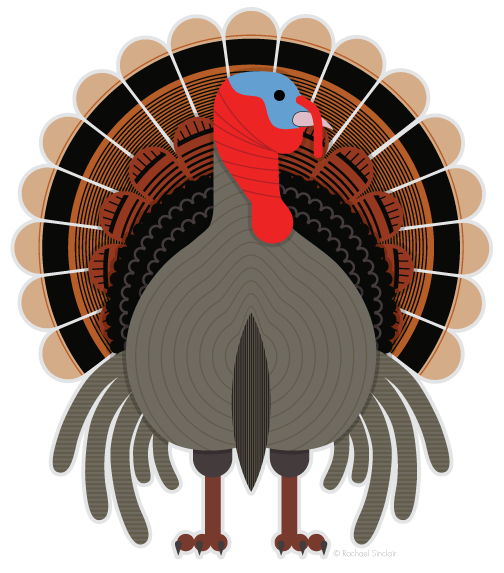 The varied topography of Kentucky is home to a wide range of plants and wildlife. The feathered variety is no exception. I love wild birds; they're fascinating and all so different. They have been a great inspiration to creatives for eons, not just for their form and color, but for their personalities, songs, and symbolism. In these posts (I hope to do a series) I will introduce you to some of Kentucky's native birds with some facts and a special illustration.
The varied topography of Kentucky is home to a wide range of plants and wildlife. The feathered variety is no exception. I love wild birds; they're fascinating and all so different. They have been a great inspiration to creatives for eons, not just for their form and color, but for their personalities, songs, and symbolism. In these posts (I hope to do a series) I will introduce you to some of Kentucky's native birds with some facts and a special illustration.As Thanksgiving approaches, our minds may conjure up the image of Tom Turkey, the jovial nodding character from the Macy's Thanksgiving Day Parade. Kentucky is home to the Eastern subspecies of Wild Turkey (Meleagris gallopavo silvestris), a large, imposing bird. Though most turkeys prepared for the holiday are the domesticated variety, bred from a Mexican turkey subspecies long ago, there's no denying the commanding presence of the wild turkey.
This bird can reach 4 feet tall and males can weigh up to 30 pounds. Their body feathers are warm brownish gray and the males have red and blue featherless skin on their heads. Males also have red waddles at the throat and base of the neck. The tail feathers, a fan of mahogany and cinnamon, are tipped with a chestnut color, thus differentiating them from the other subspecies of wild turkey.
| Habitat | Diet | Nesting | Conservation Status |

|
 |

|
|
| Open Woodland | Omnivore | Ground | Least Concern |
In the Bluegrass, wild turkeys can be found in open forests and farmland near wooded areas. They may come out to feed in fields, especially in the late summer and fall after the crops have been harvested. They're a foraging species, feeding on nuts, seeds, berries, insects, and even small reptiles. They make their nests on the ground, in shallow dirt craters protected by forest vegetation. Hens lay an average of 10-14 eggs with the young (called poults) leaving the nest mere days after hatching.
Though some may feel they have a face only a turkey mother could love, wild turkeys are strong, majestic birds in their own right. Native Americans, especially eastern tribes, favored the turkey as a food source, eating not only the meat, but the eggs. The feathers often made their way into ritual dress and equipment. So steeped in tradition was the turkey even in the infancy of the United States, Benjamin Franklin theorized it may be more fit than the Bald Eagle for the national bird. In a letter to his daughter, Franklin called the turkey a "Bird of Courage".
This Thanksgiving, as you gather with your loved ones, pay mind to the turkey. The turkey has been a source of nourishment and conviviality for thousands of years. May the blessing of food, warmth, health, and family be with you this holiday season!
Sources: Cornell Lab of Ornithology and Wikipedia



No comments:
Post a Comment